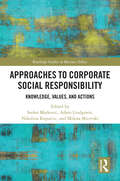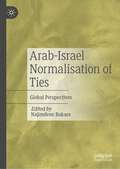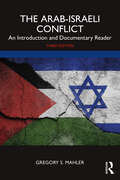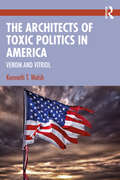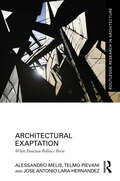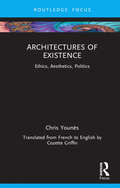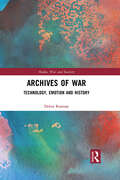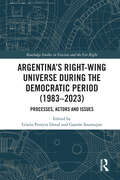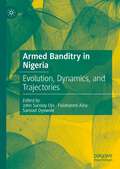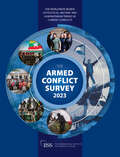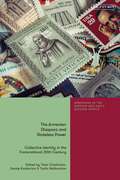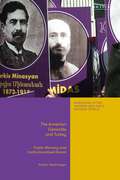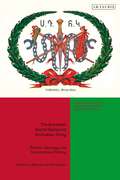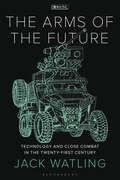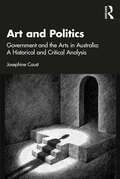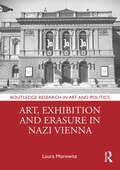- Table View
- List View
Approaches to Corporate Social Responsibility: Knowledge, Values, and Actions (Routledge Studies in Business Ethics)
by Stefan Markovic Adam Lindgreen Nikolina Koporcic Milena MicevskiFollowing recent growth of ethical consumerism, customers and other stakeholders increasingly pressure organizations to be socially responsible and minimize their negative impact on the environment. Accordingly, a plethora of firms have integrated corporate social responsibility (CSR) at the center of their business strategies and actions. Whilst this has resulted in many firms meeting their broader responsibilities toward society and the environment, some firms have used CSR in a manipulative and insincere way. As stakeholders become aware of such misuse of CSR, largely thanks to the rapid evolution of information technologies, they start to penalize firms by spreading negative word of mouth about them, and specifically about their CSR knowledge, values, and actions. Now, more than ever before, stakeholders are increasingly critical and cautious in their assessments of firms’ CSR knowledge, values, and actions. On this background, this edited volume sheds light on different internal and external perspectives spanning CSR knowledge, values, and actions. It shares theoretical, practical, and case-based insights on the broader topic and can be of interest to researchers, academics, practitioners, and advanced students in the fields of CSR and business ethics, knowledge management, strategy, and marketing.
Arab-Israel Normalisation of Ties: Global Perspectives
by Najimdeen BakareThis book focuses on rapprochement and normalisation between Israel and some Arab countries within the context of global and regional geopolitics, bringing together broader perspectives on transformations resulting from this. The analysis is rooted in a historical and cultural construction of the region as an Islamic sphere viewing Israel as a perpetuation of the Western colonial project in the region. It analyses how this normalisation must not be treated as a novel phenomenon, but as a reconstruction of the past and continuity in tradition geared at regional stability, signifying a wider shift in the structure of the global international system. The first section addresses the international perspectives of the changing dynamics through the lens of US domestic politics, disengagement plans, China’s increasing understanding of the geopolitics of the Abrahamic world. It equally pays enough attention to the attendant implications of this normalisation. The second section of the book explores the reflections of regional (state and non-state) actors, such as Turkey, Iran, Syria, Pakistan, and Hezbollah, and the catalysing effects of this normalisation within and beyond the region. The book is a rich resource for scholars of regional and international relations, in particular Middle East studies. It provides useful reading material for both undergraduate and graduate students of Political Science, think tanks, diplomats, and IR experts and policy analysts, who are desirous of having rich theoretical and empirical underpinnings of unfolding realities in the larger Middle East.
The Arab-Israeli Conflict: An Introduction and Documentary Reader
by Gregory S. MahlerThis textbook examines the diplomatic and historical setting within which the Arab-Israeli conflict has developed, and gives students the opportunity to study the Middle East peace process through a presentation of primary documents that have been instrumental in the development of the conflict from the mid-1800s through the present. This third edition includes an updated and expanded introduction and a significant expansion of the number of documents. The Arab-Israeli Conflict: includes an extensive introductory chapter which presents the history of the conflict and covers events from the nineteenth century to the present day presents 120 of the most important and widely cited documents in the history of the Israeli-Palestinian conflict in an edited form to highlight key elements incorporates a number of pedagogical aids, including the (edited) original documents, maps, and boxed sections that offer greater explanation of detailed topics presents "both sides" of the argument, allowing students to understand both the Israeli and the Palestinian positions on the issues This important textbook is an essential aid for courses on the Arab-Israeli conflict and the Middle East peace process, and will be an invaluable reference tool for all students of political science, Middle East studies and history.
The Arab-Israeli Conflict: An Introduction and Documentary Reader
by Gregory S. MahlerThis textbook examines the diplomatic and historical setting within which the Arab-Israeli conflict has developed, and gives students the opportunity to study the Middle East peace process through a presentation of primary documents that have been instrumental in the development of the conflict from the mid-1800s through the present. This third edition includes an updated and expanded introduction and a significant expansion of the number of documents. The Arab-Israeli Conflict: includes an extensive introductory chapter which presents the history of the conflict and covers events from the nineteenth century to the present day presents 120 of the most important and widely cited documents in the history of the Israeli-Palestinian conflict in an edited form to highlight key elements incorporates a number of pedagogical aids, including the (edited) original documents, maps, and boxed sections that offer greater explanation of detailed topics presents "both sides" of the argument, allowing students to understand both the Israeli and the Palestinian positions on the issues This important textbook is an essential aid for courses on the Arab-Israeli conflict and the Middle East peace process, and will be an invaluable reference tool for all students of political science, Middle East studies and history.
The Architects of Toxic Politics in America: Venom and Vitriol
by Kenneth T. WalshThe Architects of Toxic Politics in America: Venom and Vitriol explains the history of poison politics in America by profiling some of the key political “attack dogs” who have shaped the modern landscape.Comparing and contrasting the Trump and Biden presidencies with administrations of the past, the book explains the unique character of the current toxic political moment and the forces that have created it. The book also focuses quite extensively on “non-presidential” architects of toxic politics: other politicians, campaign strategists, activists, and media figures (and a few key figures that have fulfilled two or more of these roles). Drawing on his long career as a journalist specializing in presidential coverage, Kenneth T. Walsh argues that due to the complex, often conflicting nature of American government, the angriest, most decisive voices can command media, voter, and legislative attention and thereby maintain and consolidate power. This results in frustration, alienation, and cynicism—and ultimately, a diminishment of voter participation that can reinforce the vicious cycle and lead to electoral disaster.For anyone interested in politics, media, and the culture of “gotcha” journalism, this book will also be a valuable addition to undergraduate and graduate courses on politics, the presidency, political and media ethics, campaign history and government.
The Architects of Toxic Politics in America: Venom and Vitriol
by Kenneth T. WalshThe Architects of Toxic Politics in America: Venom and Vitriol explains the history of poison politics in America by profiling some of the key political “attack dogs” who have shaped the modern landscape.Comparing and contrasting the Trump and Biden presidencies with administrations of the past, the book explains the unique character of the current toxic political moment and the forces that have created it. The book also focuses quite extensively on “non-presidential” architects of toxic politics: other politicians, campaign strategists, activists, and media figures (and a few key figures that have fulfilled two or more of these roles). Drawing on his long career as a journalist specializing in presidential coverage, Kenneth T. Walsh argues that due to the complex, often conflicting nature of American government, the angriest, most decisive voices can command media, voter, and legislative attention and thereby maintain and consolidate power. This results in frustration, alienation, and cynicism—and ultimately, a diminishment of voter participation that can reinforce the vicious cycle and lead to electoral disaster.For anyone interested in politics, media, and the culture of “gotcha” journalism, this book will also be a valuable addition to undergraduate and graduate courses on politics, the presidency, political and media ethics, campaign history and government.
Architectural Exaptation: When Function Follows Form (Routledge Research in Architecture)
by Alessandro Melis Telmo Pievani Jose Antonio Lara-HernandezArchitectural Exaptation: When Function Follows Form focuses on the significance and the originality of the study of exaptation. It presents exaptation as an opportunity to extend architectural design towards more sustainable approaches aimed at enforcing urban resilience.The use of exaptation’s definition in architecture supports the heuristic value of cross-disciplinary studies on biology and architecture, which seem even more relevant in times of global environmental crises. This book aims to make a critique of the pre-existing and extensive paternalistic literature. Exaptation will be described as a functional shift of a structure that already had a prior, but different, function. In architecture, a functional shift of a structure that already had a function may apply to forms of decorative elements embedded in architectural components, and to both change of function of tectonic elements and the change of use of an architectural space. The book is illustrated with examples from around the globe, including China, Italy, Mexico, New Zealand, the USA and the UK, and looks at different civilizations and diverse historical periods, ranging from the urban to the architectural scale. Such examples highlight the potential and latent human creative capacity to change the use and functions, something that cities and buildings could consider when facing disturbances. Exaptation is shown as an alternative narrative to the simplifications of evolutionary puritanism. It also offers an innovative perspective and presents an opportunity to re-think the manner in which we design and redesign our cities.This book will be of interest to architecture, planning, urban design and biology researchers and students.
Architectural Exaptation: When Function Follows Form (Routledge Research in Architecture)
by Alessandro Melis Telmo Pievani Jose Antonio Lara-HernandezArchitectural Exaptation: When Function Follows Form focuses on the significance and the originality of the study of exaptation. It presents exaptation as an opportunity to extend architectural design towards more sustainable approaches aimed at enforcing urban resilience.The use of exaptation’s definition in architecture supports the heuristic value of cross-disciplinary studies on biology and architecture, which seem even more relevant in times of global environmental crises. This book aims to make a critique of the pre-existing and extensive paternalistic literature. Exaptation will be described as a functional shift of a structure that already had a prior, but different, function. In architecture, a functional shift of a structure that already had a function may apply to forms of decorative elements embedded in architectural components, and to both change of function of tectonic elements and the change of use of an architectural space. The book is illustrated with examples from around the globe, including China, Italy, Mexico, New Zealand, the USA and the UK, and looks at different civilizations and diverse historical periods, ranging from the urban to the architectural scale. Such examples highlight the potential and latent human creative capacity to change the use and functions, something that cities and buildings could consider when facing disturbances. Exaptation is shown as an alternative narrative to the simplifications of evolutionary puritanism. It also offers an innovative perspective and presents an opportunity to re-think the manner in which we design and redesign our cities.This book will be of interest to architecture, planning, urban design and biology researchers and students.
Architectures of Existence: Ethics, Aesthetics, Politics
by Chris YounèsArchitectures of Existence proposes that philosophical thinking (ecosophical thinking) can inform the way we engage with our world and its inhabitants, as architects, designers and planners, but also as individuals, as people, and as a society. In Art et existence, Maldiney states: "For us, to inhabit is to exist". This book aims to unfold, extend, articulate and thicken this postulate by interweaving architecture, city, landscape, literature and philosophy. It takes up the synergistic lines of long-term research carried out from an ecosophical perspective. Such an attitude explores an art of existing in multiplicity, singularity and openness, manifesting the critical dimension through a reinterpretation of the knotting of the trajectories of time, humanity and its becoming. Insisting on what is between things and beings as well as on what is happening, regenerating, recycling, reviving, saving, diversifying, sparing, recreating, meditating: and so caring. These are all eco-rhythms of a different type between human and non-human, to consider ourselves in the world. In an era of uncertainty and climate threats, this book develops the margins of possibility offered by the subject of architecture. This book will be of interest to researchers and students of architecture, urban planning and philosophy.
Architectures of Existence: Ethics, Aesthetics, Politics
by Chris YounèsArchitectures of Existence proposes that philosophical thinking (ecosophical thinking) can inform the way we engage with our world and its inhabitants, as architects, designers and planners, but also as individuals, as people, and as a society. In Art et existence, Maldiney states: "For us, to inhabit is to exist". This book aims to unfold, extend, articulate and thicken this postulate by interweaving architecture, city, landscape, literature and philosophy. It takes up the synergistic lines of long-term research carried out from an ecosophical perspective. Such an attitude explores an art of existing in multiplicity, singularity and openness, manifesting the critical dimension through a reinterpretation of the knotting of the trajectories of time, humanity and its becoming. Insisting on what is between things and beings as well as on what is happening, regenerating, recycling, reviving, saving, diversifying, sparing, recreating, meditating: and so caring. These are all eco-rhythms of a different type between human and non-human, to consider ourselves in the world. In an era of uncertainty and climate threats, this book develops the margins of possibility offered by the subject of architecture. This book will be of interest to researchers and students of architecture, urban planning and philosophy.
Architekturleistungen des Späthistorismus: Nachblüte der Stilbaukunst um 1900 (Architekturen #77)
by Christian RablKaum ein Architekturphänomen ist dermaßen mit Diskredit behaftet wie der Späthistorismus, dessen künstlerische Gelingensbedingungen durch den Kulturumbruch des Fin de Siècle delegitimiert scheinen. Auch wenn die Stilbaukunst um und nach 1900 das bürgerlich-kapitalistische Zeitalter repräsentierte, so lassen sich darunter innovative Ansätze und eklektizistische Weiterschöpfungen ausmachen. Christian Rabl systematisiert diese stilarchitektonischen Fortschritte in ihren Einzelphänomenen - unter anderem an den späthistoristischen Stadtästhetiken von Madrid, Bukarest, Riga, Barcelona und Karlsbad.
Archives of War: Technology, Emotion and History (Media, War and Security)
by Debra RamsayThis book offers a comparative analysis of British Army Unit War Diaries in the two World Wars, to reveal the role played by previously unnoticed technologies in shaping the archival records of war. Despite thriving scholarship on the history of war, the history of Operational Record Keeping in the British Army remains unexplored. Since World War I, the British Army has maintained daily records of its operations. These records, Unit War Diaries, are the first official draft of events on the battlefield. They are vital for the army’s operational effectiveness and fundamental to the histories of British conflict, yet the material history of their own production and development has been widely ignored. This book is the first to consider Unit War Diaries as mediated, material artefacts with their own history. Through a unique comparative analysis of the Unit War Diaries of the First and Second World Wars, this book uncovers the mediated processes involved in the practice of operational reporting and reveals how hidden technologies and ideologies have shaped the official record of warfare. Tracking the records into The National Archives in Kew, where they are now held, the book interrogates how they are re-presented and re-interpreted through the archive. It investigates how the individuals, institutions and technologies involved in the production and uses of unit diaries from battlefield to archive have influenced how modern war is understood and, more importantly, waged. This book will be of much interest to students of media and communication studies, military history, archive studies and British history.
Archives of War: Technology, Emotion and History (Media, War and Security)
by Debra RamsayThis book offers a comparative analysis of British Army Unit War Diaries in the two World Wars, to reveal the role played by previously unnoticed technologies in shaping the archival records of war. Despite thriving scholarship on the history of war, the history of Operational Record Keeping in the British Army remains unexplored. Since World War I, the British Army has maintained daily records of its operations. These records, Unit War Diaries, are the first official draft of events on the battlefield. They are vital for the army’s operational effectiveness and fundamental to the histories of British conflict, yet the material history of their own production and development has been widely ignored. This book is the first to consider Unit War Diaries as mediated, material artefacts with their own history. Through a unique comparative analysis of the Unit War Diaries of the First and Second World Wars, this book uncovers the mediated processes involved in the practice of operational reporting and reveals how hidden technologies and ideologies have shaped the official record of warfare. Tracking the records into The National Archives in Kew, where they are now held, the book interrogates how they are re-presented and re-interpreted through the archive. It investigates how the individuals, institutions and technologies involved in the production and uses of unit diaries from battlefield to archive have influenced how modern war is understood and, more importantly, waged. This book will be of much interest to students of media and communication studies, military history, archive studies and British history.
Argentina’s Right-Wing Universe During the Democratic Period: Processes, Actors and Issues (Routledge Studies in Fascism and the Far Right)
Argentina’s Right-Wing Universe During the Democratic Period provides a comprehensive analysis of the course of right-wing politics in the country in the last 40 years. In 1983, after the fall of a violent military regime, Argentina began the longest period of democratic stability in its history—40 years marked by economic, institutional, social and political crises. This book examines the trajectory of the different right-wing organisations and ideological developments during these years, seeking to understand both the distinctions and the continuities that lie beneath its metamorphoses. Argentina has always acted as a laboratory in which to appreciate how the major problems and questions that concern those who have studied the right-wing in recent decades are translated into a particular political culture. In an international scenario marked by the social and political growth of different right-wing movements, some of which pose a threat to liberal democracies, the study of the Argentine case can provide greater clarity and a different perspective on problems that transcend this specific national case. This book will be of interest to scholars of Argentinian and Latin American politics and history, as well as specialists on the comparative politics of the radical right.
Argentina’s Right-Wing Universe During the Democratic Period: Processes, Actors and Issues (Routledge Studies in Fascism and the Far Right)
by Gisela Pereyra Doval Gastón SouroujonArgentina’s Right-Wing Universe During the Democratic Period provides a comprehensive analysis of the course of right-wing politics in the country in the last 40 years. In 1983, after the fall of a violent military regime, Argentina began the longest period of democratic stability in its history—40 years marked by economic, institutional, social and political crises. This book examines the trajectory of the different right-wing organisations and ideological developments during these years, seeking to understand both the distinctions and the continuities that lie beneath its metamorphoses. Argentina has always acted as a laboratory in which to appreciate how the major problems and questions that concern those who have studied the right-wing in recent decades are translated into a particular political culture. In an international scenario marked by the social and political growth of different right-wing movements, some of which pose a threat to liberal democracies, the study of the Argentine case can provide greater clarity and a different perspective on problems that transcend this specific national case. This book will be of interest to scholars of Argentinian and Latin American politics and history, as well as specialists on the comparative politics of the radical right.
Armed Banditry in Nigeria: Evolution, Dynamics, and Trajectories
by John Sunday Ojo Folahanmi Aina Samuel OyewoleIn Nigeria, armed banditry has emerged as a contemporary threat to national security. Commentators and scholars have repeatedly pointed to overlapping foci such as herders-farmers' conflicts, warlordism, ungoverned spaces, transnational criminal networks, and the proliferation of Small Arms and Light Weapons (SALW) from Libya as dynamics influencing the current security dilemma in Nigeria. The emergence of armed banditry has triggered the prevalence of everyday killings, kidnapping for ransom, property destruction, and cattle rustling. However, the group's origin remains obscure, while its objectives and organizational structure are fuzzy.This book aims to unravel the evolution, dynamics, and trajectories of armed banditry in Nigeria. As it explores the activities of armed banditry in Nigeria, the debate will focus on its historical context, socio-economic consequences, transnational dimensions, and the response to armed banditry in Nigeria. Furthermore, the book will explore whether the scourge of armed banditry represents a new terrorist organization with a distinct ideological orientation (if at all) or another non-state armed group creating and profiting from a criminal economy through the reign of terror. In response to the increasing concern for the criminal activities of armed banditry in Nigeria, the book anticipates unpacking its emerging trends and operational nomenclature.
Armed Conflict Survey 2023
by The International Institute for Strategic Studies (IISS)The Armed Conflict Survey 2023 provides an exhaustive review of the political, military and humanitarian dimensions of active armed conflicts globally in the period from 1 May 2022–30 June 2023. The review is complemented by a strategic analysis of regional and global drivers and conflict outlooks, providing unique insights into the geopolitical and geo-economic threads linking conflicts regionally and globally, as well as into emerging flashpoints and political risks to monitor. This edition’s regional-focused approach also includes Regional Spotlight chapters on selected key conflict trends of regional and global importance. Reflecting the growing significance of geopolitical factors in shaping current conflict trends across the world, The Armed Conflict Survey 2023 features the third edition of the IISS Armed Conflict Global Relevance Indicator, which compares the global relevance of armed con□ icts in terms of their geopolitical impact, as well as their human impact and intensity. This edition also includes maps, infographics, key statistics and the accompanying Chart of Armed Con□flict.
Armed Conflict Survey 2023
by The International Institute for Strategic StudiesThe Armed Conflict Survey 2023 provides an exhaustive review of the political, military and humanitarian dimensions of active armed conflicts globally in the period from 1 May 2022–30 June 2023. The review is complemented by a strategic analysis of regional and global drivers and conflict outlooks, providing unique insights into the geopolitical and geo-economic threads linking conflicts regionally and globally, as well as into emerging flashpoints and political risks to monitor. This edition’s regional-focused approach also includes Regional Spotlight chapters on selected key conflict trends of regional and global importance. Reflecting the growing significance of geopolitical factors in shaping current conflict trends across the world, The Armed Conflict Survey 2023 features the third edition of the IISS Armed Conflict Global Relevance Indicator, which compares the global relevance of armed con□ icts in terms of their geopolitical impact, as well as their human impact and intensity. This edition also includes maps, infographics, key statistics and the accompanying Chart of Armed Con□flict.
The Armenian Diaspora and Stateless Power: Collective Identity in the Transnational 20th Century (Armenians in the Modern and Early Modern World)
by Talar Chahinian, Sossie Kasbarian and Tsolin NalbantianFrom genocide, forced displacement, and emigration, to the gradual establishment of sedentary and rooted global communities, how has the Armenian diaspora formed and maintained a sense of collective identity? This book explores the richness and magnitude of the Armenian experience through the 20th century to examine how Armenian diaspora elites and their institutions emerged in the post-genocide period and used “stateless power” to compose forms of social discipline. Historians, cultural theorists, literary critics, sociologists, political scientists, and anthropologists explore how national and transnational institutions were built in far-flung sites from Istanbul, Aleppo, Beirut and Jerusalem to Paris, Los Angeles, and the American mid-west. Exploring literary and cultural production as well as the role of religious institutions, the book probes the history and experience of the Armenian diaspora through the long 20th century, from the role of the fin-de-siècle émigré Armenian press to the experience of Syrian-Armenian asylum seekers in the 21st century. It shows that a diaspora's statelessness can not only be evidence of its power, but also how this “stateless power” acts as an alternative and complement to the nation-state.
The Armenian Genocide and Turkey: Public Memory and Institutionalized Denial (Armenians in the Modern and Early Modern World)
by Hakan SeckinelginHow is official denial of the Armenian genocide maintained in Turkey? In this book, Hakan Seckinelgin investigates the mechanisms by which denial of the events of 1915 are reproduced in official discourse, and the effect this has on Turkish citizens. Examining state education, media discourse, academic publications, as well as public events debating the Armenian genocide, the book argues that, at the public level, there exists a 'grammar' or 'repertoire' of denial in Turkey which regulates how the issue can be publicly conceptualised and understood. The book's careful analysis examines the way that knowledge about the genocide is censored in Turkey, from the language that must be used to publicly discuss it, to the complex way in which selective knowledge and erased history is reproduced, from 1915 and subsequent generations until today. It argues that denialism has become important to a certain kind Turkish national identity and belonging – and suggests ways in which this relationship can be unpicked in future.
The Armenian Social Democrat Hnchakian Party: Politics, Ideology and Transnational History (Armenians in the Modern and Early Modern World)
by Bedross Der MatossianThis book, based on new research, sheds light on the history of the Social Democrat Hnchakian Party, a major Armenian revolutionary party that operated in the Ottoman Empire, Russia, Persia and throughout the global Armenian diaspora. Divided into sections which cover the origins, ideology, and regional history of the SDHP, the book situates the history of the Hnchaks within debates around socialism, populism, and nationalism in the 19th and 20th centuries. The SDHP was not only an Armenian party but had a global Marxist outlook, and scholars in this volume bring to bear expertise in a wide range of histories and languages including Russian, Turkish, Persian and Latin American to trace the emergence and role this influential party played from their split with the Armenian Revolutionary Federation and the events of the Armenian genocide to the formation of the first Armenian Republic and then Soviet Armenia. Putting the Hnchaks in context as one of many nationalist radical groups to emerge in Eurasia in the late 19th century, the book is an important contribution to Armenian historiography as well as that of transnational revolutionary movements in general.
The Arms of the Future: Technology and Close Combat in the Twenty-First Century (New Perspectives on Defence and Security)
by Jack WatlingFrom sensor-fuzed munitions and autonomous weapons, to ground moving target indication radar, laser vibrometers and artificial intelligence, the weapons of warfare are undergoing a rapid transformation, with modern technologies reshaping how armies intend to fight in the twenty-first century. The Arms of the Future analyses how the emergence of novel weapons systems is shaping the risks and opportunities on the battlefield. Drawing on extensive practical observation and experimentation, the book unpacks the operational challenges new weapons pose on the battlefield and how armies might be structured to overcome them. At a time when defence spending across NATO is on the rise, and conflict with Russia raises new questions of what it means to fight a truly 'modern' war, Watling examines not just the arms to be employed but how they can be fielded and wielded to survive and prevail in future wars.
Art and Politics: Government and the Arts in Australia: A Historical and Critical Analysis
by Josephine CaustAustralian governments at all levels have been engaged with arts and culture in many different forms since the beginning of European settlement. The way this has occurred is documented and analysed here, both from an historical and critical perspective. Changing understandings of culture and the significance of Indigenous Culture to Australia receive special attention. While the focus is primarily directed to Federal Government engagement, there is also consideration paid to both state and local government involvement. There is attention paid to the censorship of arts practice by governments as well as the direct interventions by politicians in arts practice. Different approaches to the arts by governments are also considered, as well as attempts to develop a national cultural policy. The impact of the recent pandemic is addressed and various research reports about the arts sector and its relationship with government are also noted. There is then a final discussion about some issues that governments could address in the future, that might ensure a more sustainable Australian arts sector. This book will be of particular interest to scholars of contemporary arts, arts management, cultural history, public policy and cultural policy. It may also interest bureaucrats and politicians.
Art and Politics: Government and the Arts in Australia: A Historical and Critical Analysis
by Josephine CaustAustralian governments at all levels have been engaged with arts and culture in many different forms since the beginning of European settlement. The way this has occurred is documented and analysed here, both from an historical and critical perspective. Changing understandings of culture and the significance of Indigenous Culture to Australia receive special attention. While the focus is primarily directed to Federal Government engagement, there is also consideration paid to both state and local government involvement. There is attention paid to the censorship of arts practice by governments as well as the direct interventions by politicians in arts practice. Different approaches to the arts by governments are also considered, as well as attempts to develop a national cultural policy. The impact of the recent pandemic is addressed and various research reports about the arts sector and its relationship with government are also noted. There is then a final discussion about some issues that governments could address in the future, that might ensure a more sustainable Australian arts sector. This book will be of particular interest to scholars of contemporary arts, arts management, cultural history, public policy and cultural policy. It may also interest bureaucrats and politicians.
Art, Exhibition and Erasure in Nazi Vienna (Routledge Research in Art and Politics)
by Laura MorowitzThis book examines three exhibitions of contemporary art held at the Vienna Künstlerhaus during the period of National Socialist rule and shows how each attempted to culturally erase elements anathema to Nazi ideology: the City, the Jewess and fin-de-siècle Vienna. Each of the exhibits was large scale and ambitious, part of a broader attempt to situate Vienna as the cultural capital of the Reich, and each aimed to reshape cultural memory and rewrite history. Applying illuminating theories on memory studies, collective and public memory, and notions of "memoricide," this is the first book in English to focus on visual culture in the period when Austria was erased as a nation and incorporated into the Third Reich as "Ostmark." The organization, content and publications surrounding these three exhibits are explored in depth and set against the larger political changes and dangerous ideologies they reflect. The book will be of interest to scholars working in art history, museum studies, cultural history, memory studies, art and politics and Holocaust studies.
